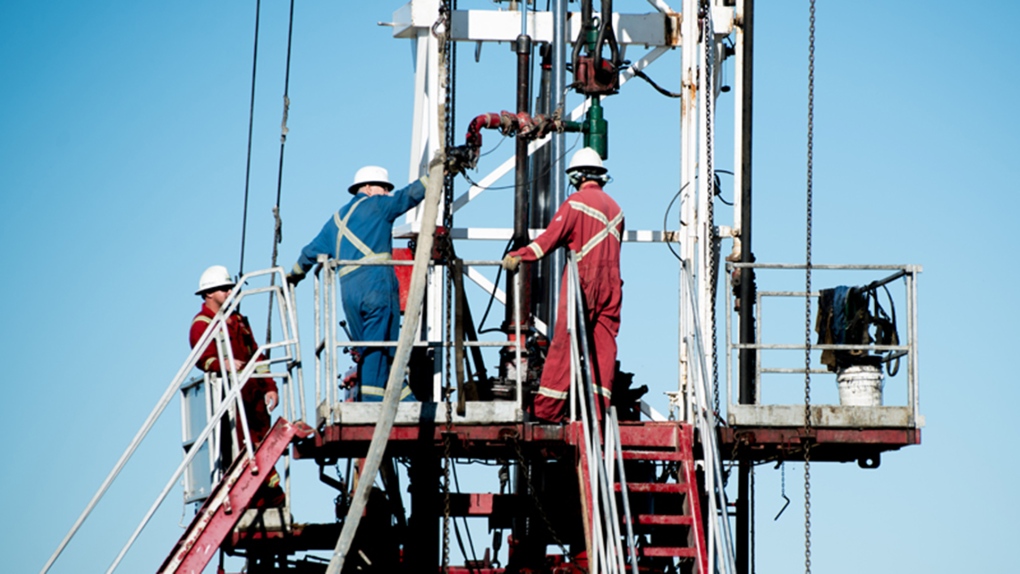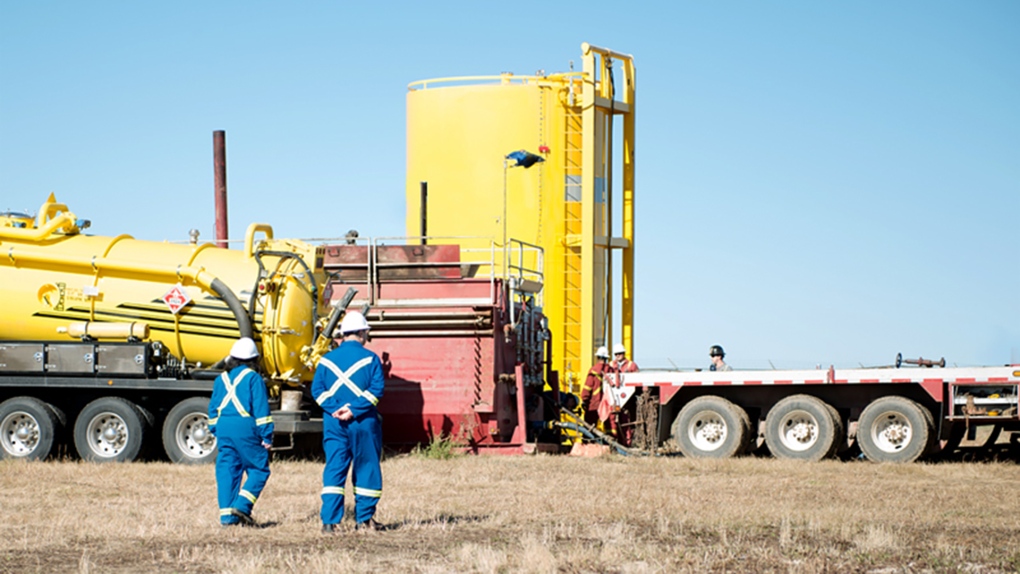'How much time do we have?': 'Contamination' in Prairie groundwater identified
 A gas well is shown being drilled near the home of Mike Judd, west of Pincher Creek, Alberta, in this handout photo from 2010. THE CANADIAN PRESS/HO, Gordon Petersen
A gas well is shown being drilled near the home of Mike Judd, west of Pincher Creek, Alberta, in this handout photo from 2010. THE CANADIAN PRESS/HO, Gordon Petersen
A compound used to treat sour gas that's been linked to fertility issues in cattle has been found throughout groundwater in the Prairies, according to a new study.
Scientists at the University of Guelph and University of Saskatchewan have identified "large contaminant plumes" of sulfolane, particularly in Alberta.
Dr. Erica Pensini, associate professor at Guelph's school of engineering, says researchers are tracking how it is spreading in groundwater, work that could help identify risks to supplies of potable water.
- Sign up for breaking news alerts from CTV News, right at your fingertips
- The information you need to know, sent directly to you: Download the CTV News App
She says the study suggests that naturally-occurring sulfates (salts) react with sulfolane in groundwater and its ability to "mix more thoroughly with water."
"Sulfolane plumes travel faster with fewer sulfates, so we're trying to clarify migration in the context of what can we do to tackle this contamination," said Pensini in a news release.
"We're also partnering up with hydrogeologists and eco-toxicologists to explore other aspects that we're not directly exploring in our lab," said Pensini.
What is sulfolane?
Sulfolane, introduced to the market in 1944 by Shell Oil, is "widely used" to remove hydrogen sulfide – a process better known as 'sweetening' – from sour gas at thousands of sites across Alberta.
Sulfolane is virtually invisible and doesn't have a particularly strong smell, so it is nearly undetectable in bodies of water.
"In most cases, you would not notice its presence," Pensini told CTV News in a statement.
According to a 2008 report by WorleyParsons Komex for Shell Energy Canada, sulfolane was first detected in groundwater in the 1980s and, in 1994, a monitoring program was put in place.
A regional sulfolane monitoring program, which began in 1998, detected sulfolane in off-site groundwater near Shell's Waterton facility.
By 2007, Shell began actively working to remove sulfolane, building on a pilot project conducted in 2003 and 2004.
Nevertheless, Pensini says the toxicity of the chemical was not fully understood, so it was improperly disposed of.
"It was therefore released in aquifers by sour gas and sour oil processing plants. There were 5,250 plants in 2007 (in Alberta), based on official sources," she said.
"Each of these plants could have released different amounts."
According to the Canadian government, "the toxicological database for sulfolane is limited."
"Overall, oral exposure to sulfolane in experimental animals was associated with immunological, renal and reproductive and developmental effects," the government's website reads.
Health Canada says the compound is not likely to accumulate in the human body, but that more than 0.3 milligrams of sulfolane per litre of drinking water is unacceptable.
"Health Canada establishes screening values for contaminants at the request of federal departments, provinces and territories (jurisdictions). These requests are usually made when there is a concern for human health because the presence of a contaminant is suspected or detected in local source water and that contaminant does not have an established limit in drinking water."
The agency says there are no regulatory limits for sulfolane in other countries, but sulfolane groundwater contamination did prompt authorities in North Pole, Alaska, to include it in the U.S. National Toxicology Program.
Research into whether or not sulfolane poses a risk to human health is still ongoing, Pensini says, but some companies have already raised concerns.
"For example, Sigma Aldrich, a leading chemical supplier, lists this hazard in their (safety data sheets)," she told CTV News in a statement.
"There is sufficient evidence for its impact on fertility for these to be officially reported."
 Crews working on a decommissioned sour gas well in south Calgary in 2017. (Supplied/AER)
Crews working on a decommissioned sour gas well in south Calgary in 2017. (Supplied/AER)
Shell working with University of Guelph
Shell Canada says it is aware of Pensini's research and has been working with the University of Guelph since 2022.
"Shell believes a collaborative and cooperative approach with academia is key to improve environmental practices," a Shell spokesperson wrote in an email to CTV News.
Shell, which has operated sour gas wells in the Foothills – Jumping Pound, Caroline and Waterton – for 70 years, says it has also worked with the Alberta Energy Regulator (AER) as well as stakeholders and landholders for the past 10 years.
In 2019, Shell sold those sour gas wells to Pieridae, but it is still responsible for "managing and remediating any impacts at the Waterton and Jumping Pound gas plants."
Shell Canada did not admit that sulfolane poses a risk to human health, but said its work with the University of Guelph "is an important step in advancing the science."
Rules in place for companies
According to the AER, the body that monitors companies in Alberta's energy sector, there are 27,562 active sour gas wells in the province, a figure that does not include inactive, abandoned and reclaimed wells.
Many more are scheduled to be drilled, the AER said in a statement to CTV News.
In addition to other regulations, the agency says all facilities that process sour gas require approval under Alberta's Environmental Protection and Enhancement Act (EPEA).
Contamination still present in Alberta groundwater
Pensini acknowledged that "practices have changed" when it comes to the handling of sulfolane.
"New sulfolane contamination is most probably less significant," she said. "Filters contaminated with sulfolane are no longer being washed directly into aquifers."
However, she adds that several decades' worth of contamination is still present in Alberta's groundwater.
Pensini says Canadian Light Source, a national research facility at the University of Saskatchewan, has been "instrumental" in understanding the spread of sulfolane.
"We can probe aspects that we couldn't probe anywhere else, so it is really, really important to us for this research," she said.
The team's findings have been published in the journal Physics of Fluids.
 (Supplied/AER)
(Supplied/AER)
The Alberta government says it's aware of the study.
"Provincial groundwater monitoring has not detected any notable increases in sulfolane levels in groundwater," said Ryan Fournier, press secretary for Environment Minister Rebecca Schulz, in a statement to CTV News.
Fournier says the government will be reviewing the study's findings.
CTVNews.ca Top Stories

Prime Minister Trudeau meets Donald Trump at Mar-a-Lago
Prime Minister Justin Trudeau landed in West Palm Beach, Fla., on Friday evening to meet with U.S.-president elect Donald Trump at Mar-a-Lago, sources confirm to CTV News.
'Mayday! Mayday! Mayday!': Details emerge in Boeing 737 incident at Montreal airport
New details suggest that there were communication issues between the pilots of a charter flight and the control tower at Montreal's Mirabel airport when a Boeing 737 made an emergency landing on Wednesday.
Hit man offered $100,000 to kill Montreal crime reporter covering his trial
Political leaders and press freedom groups on Friday were left shell-shocked after Montreal news outlet La Presse revealed that a hit man had offered $100,000 to have one of its crime reporters assassinated.
Questrade lays off undisclosed number of employees
Questrade Financial Group Inc. says it has laid off an undisclosed number of employees to better fit its business strategy.
Cucumbers sold in Ontario, other provinces recalled over possible salmonella contamination
A U.S. company is recalling cucumbers sold in Ontario and other Canadian provinces due to possible salmonella contamination.
Billboard apologizes to Taylor Swift for video snafu
Billboard put together a video of some of Swift's achievements and used a clip from Kanye West's music video for the song 'Famous.'
Musk joins Trump and family for Thanksgiving at Mar-a-Lago
Elon Musk had a seat at the family table for Thanksgiving dinner at Mar-a-Lago, joining President-elect Donald Trump, Melania Trump and their 18-year-old son.
John Herdman resigns as head coach of Toronto FC
John Herdman, embroiled in the drone-spying scandal that has dogged Canada Soccer, has resigned as coach of Toronto FC.
Weekend weather: Parts of Canada could see up to 50 centimetres of snow, wind chills of -40
Winter is less than a month away, but parts of Canada are already projected to see winter-like weather.

































